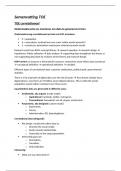Samenvatting
Samenvatting toepassing van onderzoeksmethoden en statistiek (TOE voor pedagogen) - informatie uit de hoorcolleges, literatuur en opdrachten
In deze samenvatting wordt de informatie uit de hoorcolleges, de literatuur en de opdrachten uitvoerig beschreven en uitgelegd. Het is een langere samenvatting waar alles in staat wat je nodig gaat hebben voor het tentamen van TOE voor pedagogen.
[Meer zien]




